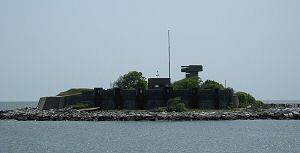|
A Brief History of Fort Wool
(1823 - 1946)
The island that Fort Wool sits on is man-made. Known as the Rip-Raps, it
was created beginning in 1818 on a shoal and is basically a big pile of
rocks. The island continued to settle after construction of the fort began
in 1826 and it was still incomplete at the start of the Civil War. The
famous Robert E. Lee began his career as a military engineer, and he took
part in the construction of Forts Wool and Monroe. Plans called for Castle
Calhoun, the original name of Fort Wool, to have three tiers of casemates
and a parapet with a total of 232 cannons. But as the island started to
settle, construction stopped during the construction of the second tier.
Only ten guns were mounted. 52 casemates of the first tier weren't
completed until 1866.
 Fort
Calhoun was used before the Civil War as a summer retreat for President
Andrew Jackson. In 1862, a name change was in order. Named after John C.
Calhoun, President Monroe's Secretary of War and Confederate sympathizer,
it was decided that it would be named after Maj. Gen. John Ellis Wool, a
Mexican War hero and commander at Fort Monroe. Fort
Calhoun was used before the Civil War as a summer retreat for President
Andrew Jackson. In 1862, a name change was in order. Named after John C.
Calhoun, President Monroe's Secretary of War and Confederate sympathizer,
it was decided that it would be named after Maj. Gen. John Ellis Wool, a
Mexican War hero and commander at Fort Monroe.
A very powerful experimental cannon, the Sawyer Gun, was installed here
during the Civil War. The range of this weapon extended all the way to
Sewell's Point in Norfolk, site of Confederate Batteries (where the
Norfolk Naval Base is now located). The Sawyer Gun also fired at the C.S.S.
Virginia during the famous Battle of the Ironclads in 1862. It never did
any damage, however. At Sewell's Point the Confederates had built an
earthen fort with bastions and a redan. There were also three other
batteries. A total of 45 guns were found here (not all were mounted) by
the Union forces after the Rebels evacuated.
A name change was proposed on July 15, 1874, but this never happened. The
name could have been Fort Scott (after Brevet Lt. Gen. Winfield Scott),
but for whatever reason the name remained the same. Seacoast Batteries
were built at the turn of the century, and an aircraft radar station was
here during World War II. During the World Wars it was commanded by Fort
Monroe. All of the original fort, except 8 casemates, was demolished. On
each of the two opposite ends of the island were searchlight towers in
1930. An anti-aircraft searchlight was located near the center of the
island. A concealed radar tower was built during WWII. A submarine net
closed off the harbor entrance between Fort Wool and Fort Monroe. After
being decommissioned it was given to the state in 1967 and in 1970 the
City of Hampton developed it into a park. The Fort Wool ferry, Miss
Hampton II, allows tourists to visit the island during most of the year.
But it can also be briefly glimpsed by cars entering the southern end of
the Hampton Roads tunnel on Interstate 64. The island continues to settle
to this very day, and occasionally the casemates of the original fortress
are put off-limits for safety reasons.
BATTERIES, BUNKERS & TOWERS:
Battery Ferdinand Claiborne: two shielded 6-inch disappearing guns
(1908-1918)
Battery Alexander Dyer: two shielded 6-inch disappearing guns (1908-1917)
Battery Horatio Gates: two shielded 6-inch disappearing guns
(1908-1917/1942); rebuilt into 229
Battery 229 (Battery 12): two 6-inch shielded guns (1944); gun tubes never
installed
Battery Henry Lee (Battery 13): four 3-inch rapid-fire guns (1905-1946);
two guns sent in 1942 to Fishermans Is.
Battery Jacob Hindman (Battery 14): two 3-inch rapid-fire guns (1905-1946)
50 caliber and 37mm Anti-Aircraft Machine Guns
Fire Control Tower (1942) - replaced a wooden tower
Two Searchlight Towers (1930) - replaced two
1921 wooden towers; demolished 1970's.
Radar Tower (1943); demolished
A.A. Searchlight Tower |